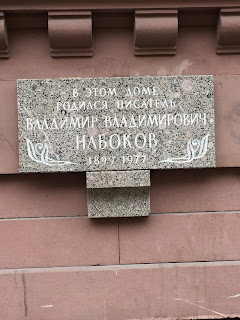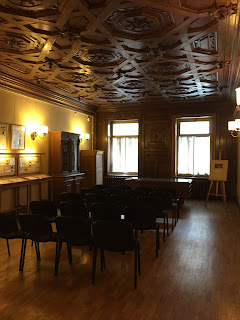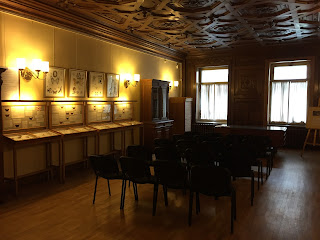80. Nabokov Museum
The author Vladimir Nabokov is best-known in the United States for "Lolita", a charming literary novel about a middle-aged pedophile. But he had a prolific and varied career that went well beyond that single work (though it's his only writing that I've ever read). He was born in Russia and spent his youth in St. Petersburg. His family moved to western Europe for political reasons in his early adulthood, and he later immigrated to the United States and finally back to western Europe. His early novels were all written in the Russian language, but during the second part of his career he wrote primarily in English. He also translated works from Russian into English (as well as from English into Russian), taught in universities, and was a noted and successful lepidopterist.
Nabokov lived for a number of years in St. Petersburg. His house has been turned into a small museum, run by St. Petersburg State University and offering free admission, a rarity in the city. Although I've not read any of his works that mention this apartment, apparently several of his books describe this home in great detail. So it is a bit of a pilgrimage site for fans.
A highlight here is a variety of "samizdat" books (unofficial copies of banned literature produced in secret) of Nabokov's early Russian writings. These titles were not officially published in the Soviet Union for decades after they written, so samizdat is the only way that people living in the USSR had access to his works. These range from professionally-produced volumes to typed or mimeographed bundles of loose pages.
The second noteworthy collection here relates to Nabokov's lepidopterical activities: moth and butterfly collections (particularly Polyommatus blues, which were his research specialty), plus his drawings of butterflies (some actual species, but most the products of his imagination) that he included in book inscriptions to his wife and close friends.
Nabokov lived for a number of years in St. Petersburg. His house has been turned into a small museum, run by St. Petersburg State University and offering free admission, a rarity in the city. Although I've not read any of his works that mention this apartment, apparently several of his books describe this home in great detail. So it is a bit of a pilgrimage site for fans.
A highlight here is a variety of "samizdat" books (unofficial copies of banned literature produced in secret) of Nabokov's early Russian writings. These titles were not officially published in the Soviet Union for decades after they written, so samizdat is the only way that people living in the USSR had access to his works. These range from professionally-produced volumes to typed or mimeographed bundles of loose pages.
The second noteworthy collection here relates to Nabokov's lepidopterical activities: moth and butterfly collections (particularly Polyommatus blues, which were his research specialty), plus his drawings of butterflies (some actual species, but most the products of his imagination) that he included in book inscriptions to his wife and close friends.




















Comments
Post a Comment